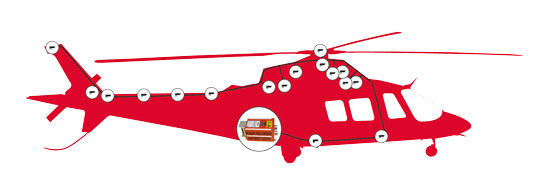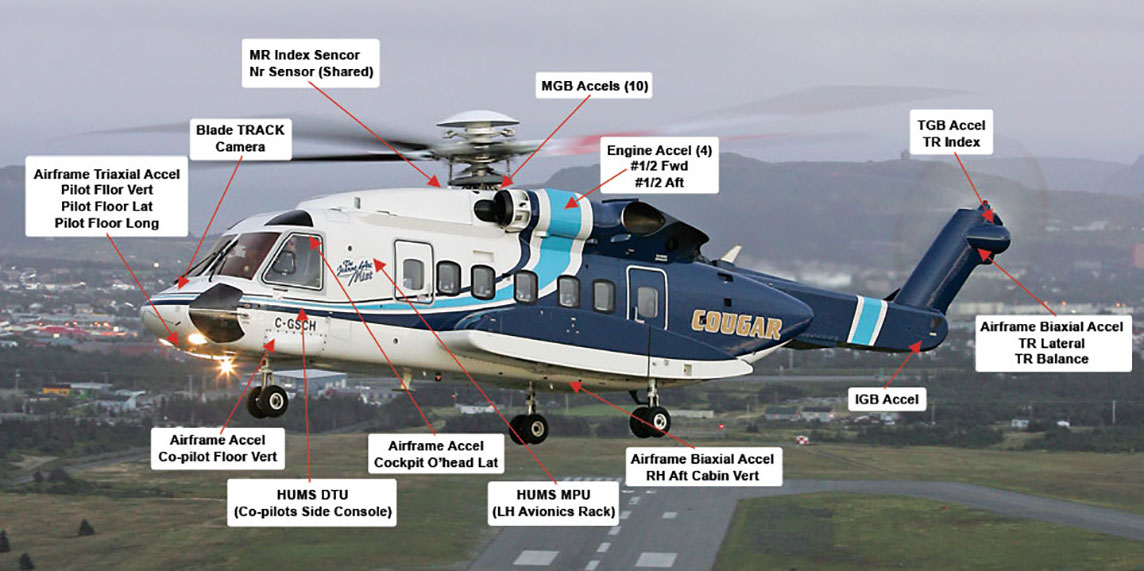Preventive maintenance has always been a key element to keeping aircraft flying. Now more than ever.
Fixing a problem before it becomes a problem has always been a major tenant in helicopter maintenance, with a large part of this ‘preventive maintenance’ practice based on estimating how many flight hours or cycles
a part could safely be used, adding a ‘fudge factor’ for increased safety before it was overhauled or replaced.
While this system worked, it left a lot of good usage on parts being replaced, or overhauls being done before they were really needed. Today, the increasing sophistication of health monitoring systems, combined with the growing use of sensors on helicopters’ dynamic components, is allowing OEMs and operators to extend the use of those parts.
Health Usage and Monitoring Systems (HUMS) have been around for years. But like a fine wine, are improving with age, something that manufacturers are keenly taking advantage of to significantly expand the lives of their components.
The increasing capability of HUMS on the worldwide S-92 fleet is allowing Sikorsky to develop what it calls ‘usage-based lifing.’ This is a methodology that was approved by the Federal Aviation Authority (FAA), allowing Sikorsky “to leverage the millions of flight hours [from the S-92 fleet] to grant extensions on selected life-limited components,” according to Simon Gharibian, Sikorsky’s director, Fleet Management, Supportability & Training.
The key is over a million flight hours collected from a combination of discrete sensors on the aircraft, plus standard data flowing through the aircraft data buses. The system was designed with “a high enough design assurance level that we’ve got the FAA to allow us to use that data to grant a one-time life extension. We believe this was a first for the FAA,” Gharibian said.
The first component to receive a life extension was the main rotor hub. The life limitations were based on anticipated flight cycles. “We are able to go back into the HUMS history of a particular rotor hub, which is tricky in itself since some operators might move the hub from one aircraft to another. But we are essentially able to capture the entire life usage on a particular serial number hub, no matter what aircraft it was on. We could then show in certain cases that the number of ground-air-ground cycles were less than what we had assumed, which allows us to apply the approved methodology and grant a one-time service life extension.”
Gharibian noted that this was “just the tip of the iceberg in that it established the precedent that we have enough confidence in our HUMS information, we have enough confidence in the chain-of-custody of that information, that we can base important decisions like life extensions on it.
“That is where we are heading. We want to extend that capability to more complexly loaded parts. The hub was a relatively simple one-parameter load case. We are working with the FAA on a number of high value components that would return significant value to our customers. We have enough information from the S-92 from the HUMS system that would allow us to essentially understand what the part has gone through during its time on the aircraft and reconstruct what its actual life consumption is versus the design assumption.”
He added that there is also a continuous improvement aspect to the way Sikorsky has deployed HUMS. Whenever a degraded part is found during either a scheduled or unscheduled inspection, “the HUMS team can go back into the aircraft data to determine if there were any indications that could have given early warning that the issue was occurring. If there was, the team can then build a special tool that searches for those same signatures in new data coming off the aircraft and deploy that to the fleet. So going forward, ever time you run the HUMS ground station toolset on the data, it is now running that extra check, looking for the specific signatures that predict that issue.”

However, putting a complete health monitoring system on a helicopter, plus a large range of sensors on multiple components, is expensive in both money and weight. So the task before manufacturers of smaller helicopters is to develop lightweight system that can provide the data needed at a lower cost.
Airbus Helicopters is working on a health monitoring system that will bring down both the cost and the weight, initially developing the system for its H145. “The idea is to have a very low level of investment so there is low cost to the customer, and be able to receive the data from the helicopter to earth. We will then collect the data and make recommendations to the customer to enable him to know which part should be inspected or replaced,” said Fabrice Gonfalone, project manager.
This new system that will allow this HUMS technology in smaller, lighter aircraft is still in in the early stages, with Airbus Helicopters working with vendors, he said. However, the system is expected to be certified on the H145 this October, to be followed by systems for the H125, H130 and H135.
The technology philosophy behind the system is based on what is currently being used in the automobile industry to allow dealers to know when maintenance is due on a specific car, he said.
One of the keys to the smaller system is the reduction in wire bundling. Bundling on larger helicopters can weigh as much as 50 lbs. to 100 lbs. Bundling on the smaller system should be around 7 lbs, depending on the aircraft, but no more than 20 lbs., Gonfalone said.
While the growth in health monitoring technology is growing rapidly, using the data provided by that technology is equally important.
The growing interest in health monitoring is becoming “a huge thing” in maintenance education, according to Keith Wilson, a program manager for Embry-Riddle WorldWide. “We have activities embedded in many of our aviation maintenance operations courses were we ask the students to consider the software applications and business solutions that are available for aircraft operators to help them do better trend analysis.”
He added that “we have our students explore emerging technologies that are out there, then debate them. We are able to glean a lot of data now. One of the emerging challenges will be developing a cadre of aircraft maintenance people who can connect the dots between all of that data, then take that data and determine the results of the data as they apply it to aircraft maintenance operations.
“You can collect data all day long. But if you are not able to apply that in a meaningful way to drive change or efficiencies, it’s not that helpful.”
Education aimed at using data derived from health monitoring systems is “an area we are going to see more resources thrown at. The data must be used as it relates to the aircraft operating system – and is what it is telling you exactly correct?”
Another current trend is the use of interactive maintenance manuals (IETMS) that can be linked with the HUMS data, Gharibian said. “This is a computer-based manual that can now embed things like 3-D graphics, animation and videos. So if I’m a maintainer and there’s a critical inspection or a critical assembly or disassembly process, I can actually embed a video so I can watch the procedure being conducted, seeing all the things I need to inspect.”
Some of this has come from the military side, “particularly the U.S. Navy,” he said. “They have really pushed the envelope with interactive technical manuals, so we’re pulling over things like monolithic wiring diagrams. It used to be in the past you’d have a wiring diagram that was 10 pages, and you’re flipping from one page to the next, trying to figure out where all the wiring goes. With the interactive technical manual there is one big wiring diagram that you can move around, zoom in on and then literally, if you’re doing point to point continuity checks, you can change the color of the wires as you do the check. Change it so that if connectivity is good, it’s green. If connectivity is bad, it’s red. These types of tools accelerate the time needed to troubleshoot an issue.”
